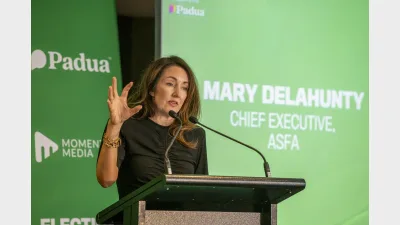Superannuation funds make insurance a priority


Insurance and how it is delivered has not only become a key differentiator for superannuation funds, but also a market imperative for the big group insurers, writes Damon Taylor.
If one truth has emerged for Australia’s superannuation industry throughout the challenges of this global financial crisis, it is that despite declining investment markets and despite wider economic upheaval, market competition remains a constant.
Funds have become strongly aware of the need to stand out from the crowd, and according to Andrew Howard, head of group insurance for MLC, most have realised that insurance provides them with the opportunity to do exactly that.
“Insurance has become a key focus for trustees, and that wasn’t the case previously,” Howard said. “It’s now a competitive feature of the total superannuation package, and that’s vastly different from where it started as a very basic requirement.
“Back then it was a modicum of cover on a dollar rate,” he continued. “But that’s a thing of the past now.”
“Insurers and trustees alike are starting to work on benefit designs in the hope of providing fund members with better insurance coverage.”
Howard said the biggest indication of how far the insurance industry had come in recent years lay in the idea that people be provided with cover when they needed it the most.
“Scale-based insurance cover is becoming a thing of the past,” he said. “People take on mortgages, get married and have, children and that’s when they need insurance cover the most.”
Reflecting on whether insurance priorities had changed in the last five to 10 years, Geoff Black, chief executive officer, group risk and alliances for Tower, said the underinsurance message had certainly been getting across.
“IFSA [the Investment and Financial Services Association], ASFA [the Association of Superannuation Funds of Australia], other industry bodies and the trustees themselves have become aware that the historical $1 a week life cover is insufficient and not meeting Australia’s insurance needs,” he said.
“We’ve seen shifts in benefit designs to a needs-based approach that continues to consider affordability and we’ve observed default levels of death and TPD [total permanent disability] cover going up.
“We’ve seen the introduction of default income-protection insurance, more choice around insurance design and meaningful research into insurance needs,” continued Black.
“By and large, trustees have been pretty active in bringing a more contemporary insurance offering to their members, and I think insurers have helped them with that.”
In terms of what boxes super funds were looking to tick when it came to their insurance, Phil Collins, general manager, life, for International Underwriting Services (IUS), said the insurance industry was starting to see very clear moves towards a more sophisticated offering.
“Instead of getting X amount of cover at an early age for their members and then having it diminish, funds are looking at increases for life events, better forms of disablement cover and the extension of cover to older ages.
“Funds are aware that insurance needs to be flexible and that there’s a strong need to carry it forward through to later ages.”
Howard said a fund’s number one priority was to provide all members with a basic level of cover regardless of how a member may have come into the fund.
“From there, they’re looking for insurers to provide that with low to no underwriting and to provide it with flexibility,” he said.
“They’re looking for good benefit design, so cover when their members need it and, finally, they’re looking for an offering that goes beyond basic cover to allowing members to option-up into higher levels of cover.
“At the end of the day, funds are looking for a holistic insurance offering.”
Yet the reality of competition and the role insurance has to play within that means that there have to be differentiators within superannuation insurance.
Claims management and the claims experience is often pointed to by super funds as being vital to the insurance relationship, but Collins sees it as a natural flow on from insurance’s great share of the spotlight.
“In the old days insurance was paid for by employers and it only catered to the most basic requirements,” he said.
“So in those sort of circumstances, people weren’t nearly as concerned about claims timeliness or the manner in which a claim was handled.
“Now it’s an entirely different environment — insurance is compulsory and it commands far greater attention,” Collins continued.
“Funds aren’t employers, they’re looking to hold and attract members; to do that they have to make everything, insurance included, run as smoothly and efficiently as possible.
“That means that efficient payment of claims is now the priority that it always should have been.”
And when asked what the difference between good claims management and bad claims management could mean in terms of delay, Collins was quick to state that there was far more to it than just time.
“It has to be about compassion and understanding the client’s needs as well,” he said. “People may be off work for many years if they make a claim so how well the insurer responds is as important as how quickly.
“We’re talking about a whole way of dealing with clients that minimises what they have to do and eases their pain.”
For his part, Howard said he wished he could see more super funds placing claims management and the claims experience at the top of their priority lists.
“Normally funds’ first insurance focus is price and benefits,” he said. “But funds need to know that their insurers will be there when they’re needed the most.
“At MLC for instance, we try not to take an adversarial approach,” Howard continued. “We want to work with our funds, to not take a black or white position, to work in the grey if you like.
“Price and level of benefit may well come first but we think the claims experience is what sustains the relationship.”
However, if the claims experience sustains the insurance-super fund relationship, the power behind that experience is surely technology. It is a facet of financial services delivery that is playing a more and more important role, and for Howard there are two levels to it.
“The first level is in the business to business interactions between the insurer and the fund,” he said. “So making sure data is transmitted securely for underwriting and claims and that it is easy to understand.
“The second part is the insurer/fund — member side of things,” Howard continued. “And that’s the ability of consumers to interact with their funds, to see through to their insurer and back again.”
But when it comes to bang for buck in insurance, Howard said that beyond good processes and good member interaction, it was most important to have the right people in place.
“Insurance is an emotional business,” he said. “When a member is applying for cover or making a claim, they’re likely to be feeling fairly upset so for us, the most important place to spend money on is really well skilled and experienced insurance professionals.
“In emotional events, people need to speak with someone who knows what they’re talking about,” Howard added. “Streamlining processes is all well and good but when it comes to priorities, it has to be people first and technology second.”
Also looking beyond the process development possible through technology, Black looked to education and awareness as areas where insurers’ technology dollar could be well spent.
“At the front-end technology has to make underwriting and the application process easy and at the back-end it enables fund members to go online, see what they need to do and then track their claim,” he said.
“But on the back of investment performance publicity, people are engaging more with their super and there’s an opportunity to get some great information out there.”
“The education of members around how much and what type of cover they require is critically important.
As a long-time proponent of insurance and superannuation education, Collins said while it was important to develop underwriting engines, education was where real progression was needed.
“My personal view is that education is the key to a better understanding of insurance and, therefore, better insurance in the long run,” he said.
“If we can put an education process into schools, even at the high school level, we can ensure that when our kids head out into the world, they aren’t daunted by the vast number of financial choices and decisions out there.
“At the moment, they’re entering that field unarmed simply because we’re not empowering them with the right knowledge.”
Unfortunately, while claims, education and awareness are new focal points for super funds and insurers looking to improve their insurance offerings as a rounded package, it is very hard to get away from price per unit of cover as the bottom line.
However, for Collins, insurance focal points, whether benefit design and innovation or the basics of premium and cover, are somewhat cyclical.
“The super industry seems to go through periods where insurance is a competitive feature and, consequently, the focus between benefit design and premiums change,” he said.
“We’ll go through periods where innovation and change will be preferred, but then we’ll come back to premium change.”
“Obviously, premium changes have to be important for trustees and that’s one of the industry’s challenges,” Collins continued. “But I think it’s possible for trustees to have the best of both worlds.
“Insurance margins are still very tight so given that trustees are getting good quality insurance plans for very reasonable prices, they’re essentially getting their cake and eating it too.”
Black said when it came to the benefit design versus premium debate, every group of superannuation trustees had a different view.
“I’ve seen funds look at broader benefit designs and I’ve seen some funds focus on the basics of superannuation, so the retirement business with a lesser amount of insurance,” he said.
“But the decisions trustees are making are based on their membership’s needs and demographic.
“Competition comes into it, but it really comes down to the individual fund and where their priorities lie.”
Combining the views of Collins and Black, Howard said that while insurance priorities depended on market segment, the bottom line was that people wanted the lot.
“We no longer have a situation where having ticks in two of three boxes is enough,” he said.
“You have to have ticks in all three because the danger in going to the absolute in any one of these dimensions lies in missing an opportunity to advance in one of the others.
“Existing relationships are a perfect example,” Howard continued. “If you have an existing relationship with a good track record, the reductions in premium that come from that can be used to arrange better benefit design.”
“That’s what we see as best practice — this business is about being better across the board rather than being outstanding in any one area.”
Perhaps in line with views that super funds and their members can expect the best of both worlds in terms of benefit design and premium is the growth of income protection insurance as a default cover for superannuants, but from Collins’ perspective, it’s something that’s been on the cards for some time now.
“At IUS, we’ve been strongly in favour of income protection for a considerable time now,” he said. “And that’s because super is no longer an award — its an entitlement now.
“The whole super systems is based on earning an income so we believe that income should be insurance’s starting point,” Collins continued. “The whole system depends on that income’s continuity so protecting it is imperative.
“The challenges for insurers is to make that offer innovative enough and cost-effective enough to make it accessible.”
But while Black agreed that income protection insurance appeared to be the order of the day, he cautioned that trustees would need to continue their membership profiling.
“Income protection can become quite expensive,” he said. “So the last thing they’ll want to do is provide income protection as a default cover if their members already have it as part of some industry award.”
However, Collins is cognisant that there are many funds not seeking default income protection due to its cost.
“Cost has to be a prime consideration, but I think there’s also a reticence in some funds to provide anything on a default basis,” he said.
“And I don’t know if that’s been due to price or a matter of principle, but it’s something that’s starting to change now.
“Trustees are coming to understand that providing cover on an opt-out and default basis is the most efficient way.”
Contemplating what form the insurance landscape would take as Australia emerges from a global financial crisis that has impacted all financial services, Black said member education on their insurance needs would continue to be very important.
“As an industry, we have to make it easier for them to access cover,” he said. “And when they make a claim, that experience has to be made a whole lot quicker and more certain.
“We’ve got a superannuation environment in which contributions have been reduced and balances have been reduced,” continued Black. “And as a result, people have less money available to them for their retirement.
“The challenge for trustees is to balance those retirement needs against their members’ need for insurance.”
For Collins, the insurance focus must remain and become even more clearly set upon income protection.
“Funds and insurers will need to look at providing it as a default and not necessarily in the traditional way that we’ve become used to,” he said.
“They’ll need to look at innovative ways to provide it at a good a price because from my point of view, it’s a moral and practical necessity.”
Looking to the path ahead of the insurance and superannuation industries, Howard’s belief was that with respect to reducing underinsurance, both industries were on the right track.
“The fact is, if we didn’t have super funds offering insurance then that underinsurance gap would be a great deal worse,” he said.
“We have to accept that for most people, insurance is a lesser consideration and it will always need encouragement.
“Funds simply have to ensure that they have the right level of cover in place and that they are aware of the risks,” Howard continued.
“Because when a claimant receives their benefits, they are more than grateful for it.
“It’s something that we’re perhaps not focused enough on because that’s the side of this business that makes it all worthwhile.”
Recommended for you
Aware Super has made a $1.6 billion investment in a 99-hectare industrial precinct in Melbourne’s North which, the fund clarified, also houses the nation’s first privately funded open-access intermodal freight terminal.
ASFA has affirmed its commitment to safeguarding Australia’s retirement savings as cyber activity becomes an increasing challenge for the financial services sector.
The shadow treasurer is not happy with the performance of some within the super sector, telling an event in Sydney on Thursday that some funds are obsessed with funds under management, above all else.
As the Australian financial landscape faces increasing scrutiny from regulators, superannuation fund leaders are doubling down on their support for private markets, arguing these investments are not just necessary but critical for long-term financial stability.













